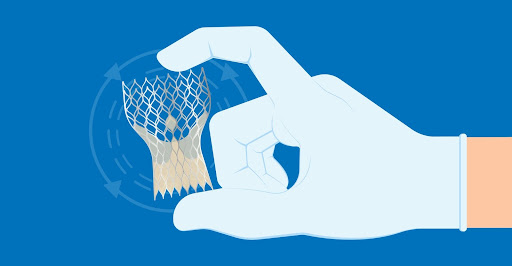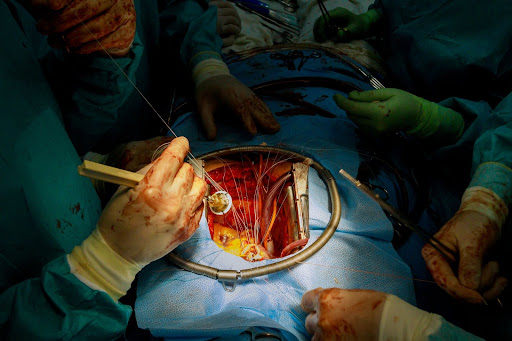TAVR vs SAVR

Types of TAVR Valves
TAVR is a new procedure that has been gaining popularity in recent years. It’s used for the treatment of aortic stenosis. It involves the use of a catheter to replace a damaged aortic valve with a biological tissue valve. The replacement valve is usually made of cow or pig tissue.
There are two main types of TAVR valves: Self-Expanding and Balloon-Expandable Valves.
Self Expanding Valves

Self expanding valves are the most common type of valve used during TAVR procedures. They usually consist of nitinol (nickel-titanium alloy) coils that expand when deployed by inserting them into the heart through a catheter. The most commonly used self-expanding valves include:
- Evolut T
- Acurate Neo
- Portico
- Allegra
Balloon Expandable Valves
Balloon expandable valves are similar to self-expanding valves in that they’re also deployed through a catheter. However, these valves have a balloon that must be inflated before they can be inserted into the heart. They are then deflated once they have been properly positioned within the ventricle chamber.
The most common types of balloon-expandable valves include:
- Sapien XT
- Sapien 3
- MyValv

If you want to undergo the TAVR procedure, make sure you consult a TAVR expert in India to understand the differences between different valves and choose the right one for you.
Longevity of SAVR
SAVR, or surgical aortic valve replacement, is one of the most common procedures for treating severe aortic stenosis. In this procedure, the heart’s diseased aortic valve is replaced with a man-made one. The average life expectancy after SAVR varies with age but can range from 5 years to more than ten years after surgery.
Life Expectancy After SAVR
A patient’s life expectancy after SAVR depends on several factors, including:
- The patient’s age at the time of surgery
- The extent of damage to the aortic valve and cardiac muscles before surgery
- The patient’s overall medical history
- The type and condition of the new valve after surgery

How Does Life Expectancy After SAVR Vary With Age?
The older you are when you undergo SAVR, the shorter your life expectancy post-surgery will be. Patients younger than 60 years old have a better chance of living longer.
Additionally, a recent study found that the average survival time for SAVR was:
- 10.9 years for low-risk patients
- 7.3 years for intermediate-risk patients
- 5.8 years for high-risk patients
Also, the study found that the median survival time was 10 years more in low-risk patients aged 60 to 64 than in those older than 85.
It’s worth noting that longevity after SAVR also depends on the type of valve you receive. Make sure you consult an experienced cardiac surgeon to assess the benefits and complications before undergoing SAVR for severe aortic stenosis.
Longevity of TAVR
TAVR, or transcatheter aortic valve replacement, is a minimally invasive procedure that uses a catheter to insert a replacement valve into the patient’s heart. The procedure is used to treat severe aortic stenosis in patients who can’t undergo open-heart surgery.
Survival After TAVR
The survival rate after TAVR is around 95%. It’s important to note that this number only applies to patients who have been diagnosed with severe aortic stenosis and meet certain other criteria. For patients who don’t meet these specific criteria, survival rates are much lower, only about 60%.
In a recent study, 5.9% of patients who underwent TAVR died or suffered a massive stroke. In comparison, 6.7% of patients who underwent surgical aortic valve replacement experienced a disabling stroke or died. Moreover, disabling stroke only affected 1.1% of TAVR patients.
Life Expectancy After TAVR
A patient’s longevity after TAVR depends on various factors, including the following:
- Age
- Medical history
- Extent of damage to the aortic valve
Also, life expectancy depends on what kind of lifestyle a patient follows after TAVR. Having said that, most patients can get a boost in life expectancy by 5 to 10 years. In a 2019 study, 91% of patients who underwent the TAVR procedure didn’t show any signs of severe valve degeneration 5 to 10 years post-implantation.
If you’ve been diagnosed with severe aortic stenosis, make sure you consult a heart valve expert in India to explore the best treatment options.
How Is SAVR Done?
Surgical aortic valve replacement (SAVR) involves open heart surgery to remove a damaged aortic valve and replace it with a mechanical or biological tissue valve. Used for the treatment of severe aortic stenosis, it can improve a patient’s quality of life and longevity.
SAVR usually involves the following steps:
- The patient receives general anesthesia before the procedure. That means they’ll remain unconscious throughout the surgery.
- The surgeon makes an incision (25 cm or smaller) in the chest to access the patient’s heart.
- The surgical team stops the patient’s heart and uses a heart-lung bypass machine to maintain blood circulation.
- The surgeon removes the faulty aortic valve and replaces it with a new one.
The SAVR procedure usually takes a few hours. Also, you’ll have to stay in the hospital for a few days post-surgery. After the surgery, you’ll receive medications and nutrition through an intravenous line. You might also have other tubes attached to your body to drain urine and other fluids.
Make sure you talk to your doctor to explore different types of replacement valves and choose the right one for you. While mechanical valves are more durable, they pose the risk of blood clots. On the other hand, biological tissue valves are prone to infection.
How Is TAVR Done?
TAVR, also known as transcatheter aortic valve implantation or TAVI, is an effective treatment option for aortic stenosis patients who can’t undergo open heart surgery. Before the procedure, the patient might receive sedatives through an intravenous (IV) line to help them relax.
Additionally, the medical team can administer blood thinners to prevent the formation of blood clots during the TAVR procedure. They might also shave the area where the incision will be made to insert the catheter.
TAVR usually involves the following steps:
- The cardiac surgeon makes a tiny incision in the groin or chest and inserts a catheter with a balloon tip into an artery.
- The surgeon uses moving X-ray images to properly position the catheter and guide it to the heart.
- Once the catheter reaches the aortic valve, a replacement valve (made from cow or pig tissue) passes through the catheter.
- The catheter’s balloon tip is inflated to insert the replacement valve into the correct position.
- The surgeon removes the catheter after the replacement valve is secured in place.
Most patients have to spend a night in the ICU after undergoing TAVR. Also, they might have to stay for a few more days, depending on their physical health after the procedure. If you’ve been diagnosed with severe aortic stenosis, a TAVI expert in India to determine whether it’s the right treatment option for you.
Complications of SAVR
SAVR can be instrumental in improving the longevity and quality of life of patients with severe aortic stenosis. It can increase a patient’s life expectancy by nearly 10 to 15 years. It’s nothing short of a new lease on life.
But, it’s worth noting that SAVR is a critical open-heart surgery. And as with any major surgery, it comes with a few risks.

To begin with, the use of the heart-lung bypass machine during the procedure increases the risk of strokes and neurological disorders. Also, patients might develop a chest wound infection (at the site of the incision). There’s even the risk of lung and bladder infections. It’s particularly common in patients with diabetes or obesity.
Other complications associated with SAVR include:
- Excessive bleeding
- Blood clots
- Arrhythmias
- Chest pain
- Reduced kidney function (temporary)
- Death
Also, there is the risk of the replacement valve faltering or failing. Keep in mind that biological tissue valves can also cause infections in the heart. Also, they may wear out or disintegrate over time and need another replacement.
If you’re planning to undergo SAVR for severe aortic stenosis, make sure you talk to your doctor about these risks and understand whether they can be life-threatening. If that’s the case, consider less invasive alternatives, such as TAVR.
Complications of TAVR
| TAVR is usually considered a safe procedure with a survival rate of 95%. It’s often the only treatment option for aortic stenosis patients who’re considered high-risk for surgery. If you’re lucky, you expect to go home within days after undergoing TAVR. |
Nevertheless, as with any medical procedure, TAVR can result in a few complications. The most serious risk associated with TAVR is the failure or slippage of the replacement valve. It may also leak, causing blood to flow back into the heart.
Additionally, the use of a biological tissue valve makes patients vulnerable to heart valve infections. If you’re undergoing TAVR, make sure your medical team administers the necessary antibiotics to minimize the risk of infection.
Other risks associated with TAVR include:
- Heart attack
- Stroke or transient ischemic attack (TIA)
- Blood clots
- Bleeding and infection (at the site of the infection)
Most patients are administered anticoagulants (blood thinners) to minimize the risk of blood clots and strokes. Moreover, failure of the replacement valve can result in an irregular heartbeat (arrhythmias). That, in turn, will require additional surgery to install a pacemaker.
It’s a good idea to talk to your doctors and understand the risks and benefits of TAVR before undergoing the procedure.

